29. The Dieng Plateau: Abode of the Gods
- Mountaintop Temples/Mount Meru link humans with gods
- The Temple/Shrines devoted to Mahabharata characters
- The Kala/Makara Motif: Vitality swallowed by Time
- Shiva: God of Destruction, Yogi & Lingam/Yoni Union
- The Dieng Volcanic Complex
- Lake Telega Warna & the Semar Cave
- Shiva, a Dravidian God, predates the Aryan Gods
- Tantra's Pervasive Influence
Indian influence reached Indonesia by the 1st century CE. However, it wasn’t until the 3rd to 6th centuries that the first Indianized kingdoms emerged in west Java, Sumatra and Borneo. As the trading network prospered, another kingdom formed in Central Java. This collection of humans did something special. They created stone temples, not just anywhere, but upon a high altitude plateau.
The Dieng Plateau is significant as the traditional center of the Javanese Empire – past and present. A ring of volcanic mountains that are between 6000 and 7000 feet high (2100 meters) surrounds this large depression.
Mountaintop Temples/Mount Meru link humans with gods
Why did the Javanese build temples here on top of a mountain, so far away from the major metropolitan centers of the coast and plain?
Early in the first millennium of the Common Era, Indian and Chinese traders expanded their operations from Borneo to a port on Java's northern coast, perhaps Semerang. Due, at least in part, to the biannual alternation of the monsoons, they intermarried with the indigenous Javanese.
The syncretic culture grew and began searching for a mountaintop to erect a temple – or a temple complex in this case. Presumably, the devotees are closer to the gods that way. Evidently, the multiple temple/shrines are meant to be miniature cosmic mountains that represent Mount Meru, the mythical Hindu mountain that connects the human world with the gods. Although plans for the shrines are based upon Hindu religious texts, they are unique to Java, only having a loose connection with Indian temples.

It is easy to see why they chose this mystical location. After a long steep drive or climb in their case, one arrives at a relatively flat, enormous, lush, rolling plain - the magical top. Misty hilltops surround the area, rendering it even more ethereal. It is easy to imagine the wonder of the group that discovered this mountain plateau and the collective enthusiasm of the kingdom's populace for constructing religious shrines here. To honor the location, this 1st millennium culture named it the Dieng Plateau, which means 'Abode of the Gods' in Javanese.
The Temple/Shrines devoted to Mahabharata characters
The Dieng Plateau is enormous. The mountainous plain is about 9 miles (14 km) long and about 4 miles (6 km) wide. This large expanse of land has many remarkable features in addition to the shrines. Following is a first-hand account of our visit to the plateau to capture the multifaceted nature of this special region.
Wonosobo, the city at the base of the ring of mountains, is literally the modern gateway to this historical spot. At the official arched entryway, we engage a guide named Sumedi.
We drive through endless terraced rice paddies – up and up – cabbage planted on the narrow walkways between the rice. Every square inch of the fertile soil is exploited to feed an immense population then and now – estimates even then of millions - not hundreds of thousands.
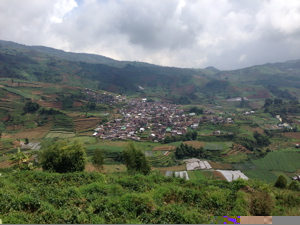
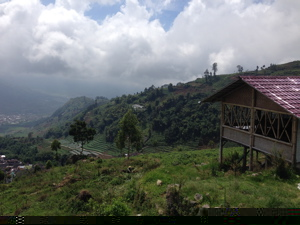
After a somewhat gradual climb in a small minivan, we finally reach the plateau on top of the mountain. Due to the surrounding uplifts, it appears that the valley was formed after an ancient volcano/caldera exploded – blowing the mountaintop off. The tectonic evidence is abundant, as we were to witness first hand.
We park the van and walk onto a grassy plain. After a short stroll, we arrive at a collection of relatively small stone shrines – perhaps 20 or 30 feet high – nothing so grand as other Javanese architectural masterpieces – but still awe-inspiring for their compact beauty.

At this location, we saw 4 Hindu temple shrines. There are 4 other shrines at other locations on the enormous plateau. While there are only 8 monuments presently, it is believed that there could have been as many as 400 at one time. Scholars believe that they were built during the Sanjaya dynasty of the Mataram kingdom from the mid 7th century to the end of 8th century CE. They are the oldest stone structures in Java. Although the symbolic designs seem to be unique to Java, the architectural style has some connection to the Dravida and Pallava style temples of Southern India.
Each shrine is a monument to a different semi-divine character from the Hindu religious novel, Mahabharata. The main temple is a monument to Arjuna the archer. The others are shrines to 2 of his wives, and Yudhishthira, the righteous warrior-king. This identification is indicated by shallow reliefs carved on the exterior walls.
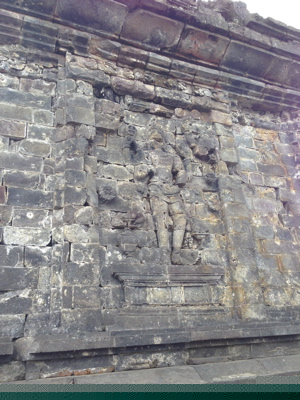

Me: "Are the Javanese still aware of the Mahabharata and its characters?"
Guide Sumedi: "Definitely."
Me: "How about the Ramayana?"
Sumedi: "Even more so."
Also in the temple complex is a casket shaped crematorium, presumably for the Sanjaya king and his descendents. The inclusion of the crematorium with the shrines associates the king and his dynasty with the gods.

The name of the dynasty, Sanjaya, is also taken from the Mahabharata. Sanjaya is the charioteer of the blind king. He relays the events of the great battle to the king. Protected by the author, Vyasa, he observes and relates what happens, but does not participate in the carnage. Although Sanjaya never fights and just watches, he expresses his distaste for the unnecessary destruction in poetic terms. Perhaps the king and his dynasty chose this name to indicate that that they had learned Sanjaya’s lesson from the Mahabharata. Rather than engage in the endemic and senseless wars of the warrior caste, they were going to serve the populace by maintaining the peace.
At driving distance from this temple complex is another shrine. It is a monument to Bhima, the son of the wind and Arjuna’s brother. Although hesitant, both Bhima and Arjuna reluctantly accepted their Dharma and entered a destructive battle between cousins.
One of the main themes of the Mahabharata is to heed the Dharma Call. The Mahabharata exerted a significant influence upon the culture that built these shrines upon the Dieng Plateau. Evidently they too were following their Dharma.
The Kala/Makara Motif: Vitality swallowed by Time
The entryway into the center of each shrine has the same motif. Two creatures from Hindu mythology surround the door. Kala is on top and Makara on the bottom. Kala represents time, while Makara could be said to represent fecundity. At the portals to the shrine, Kala's mouth is open and the Makara's serpent-like body completes his jaws. In other words, the devotee must enter through the Kala's enormous mouth to enter the shrine. The kala/makara symbolism made me laugh. Time consumes devotees as they seek vitality – the ultimate statement of the transitory nature of the human condition. As we etch the landscape with our creations, we are simultaneously marching towards death. How amusing to be reminded of this stark reality as we enter each shrine.

[As an aside, note how the line of the roof raises at the corners. This is reminiscent of Chinese temples. Could the Chinese have exerted an influence on the shrine's design?]
Employed as both a decorative and symbolic element, the kala-makara motif is unique to the ancient temples of Java. Although the earliest evidence is from the Dieng Plateau, the kala-makara motif is also found at both Prambanan, a Hindu temple complex, and Borobudur, a Buddhist monument – 2 of the most famous Javanese temples. In both cases, Kala's enormous mouth forms the top of the gateway, while the Makara serpent extends down a long staircase. Further, at Borodudur, there are a series of platforms with multiple gateways with Kala on top of each. As such, multiple Kalas can be seen from below. Intricate stone carvings of twin makaras form the stair's railings. Could the temple/shrines of the Dieng Plateau have supplied the inspiration for this symbolic motif?
In general the front half of the Makara is represented as a land animal, while the back half is a sea creature. The Makara transports Ganga, the goddess of the Ganges, and is also associated with Kamadeva, the god of love. Makara is also a sign of Hinduism's astrological Zodiac associated with Capricorn, the time when the Sun is reborn.
As an indication of the complex religious/architectural interactions in this part of the world, the Makara is also found in temples located in India, Nepal, China, Burma, Laos, Vietnam, Malaysia, Thailand and Cambodia. In the Khmer architecture at Angkor and in Laos, the Makara is often portrayed with a symbolic animal, such as a naga serpent or lion, emerging from its gaping mouth. Sometimes the animal side of the Makara is portrayed as an elephant with jewels issuing from its trunk. Each of these portrayals supports the notion that the Makara symbolizes fecundity – somewhat akin to the horn of plenty.
Shiva: God of Destruction, Yogi & Lingam/Yoni Union
Besides the kala-makara motif, each of the shrines shares another common element. They are all dedicated to Shiva. Each contains an interior altar containing a lingam and a yoni. Traditionally, a priest or devotee pours milk or water over the lingam, an erect penis and symbol of Shiva. The liquid flows into a yoni, a stylized vagina, at the base of the altar. The vagina is the symbol of Shiva's consort, Durga. (We see no lingams at these shrines, as they have been removed.)
Me: "Does a lingam ever exist alone?"
Sumedi: "Never. Lingam and yoni always together."
Me: "One inside the other?"
Sumedi: "Always."
We all know that a lingam is an erect penis and that a yoni is a vagina, but never refer to them in English. The lingam and the erection have the same denotation (precise definition). Yet an erection has an obscene connotation in English, while a lingam has a spiritual connotation in Sanskrit, the written language of both India and Southeast Asia.
This simple and direct comparison reveals volumes regarding the cultural orientation to sex in the respective cultures. In one culture, sex is a taboo topic – something that is never mentioned in polite society. In the other, sex is a tool for spiritual enlightenment. What is your underlying mindset?
Further, it seems evident that the lingam/yoni linkage, 'one inside the other', must symbolize sexual intercourse to the worshippers of Shiva, the Shaivites. Further, the milk poured over the top of the lingam certainly suggests ejaculation. This somewhat obvious symbol evokes the notion of the sexual climax, an orgasm.
If so, does this widespread symbolic representation, the lingam inside the yoni, remind Shaivites of the potential for divine ecstasy in everyday life? Does this sexual symbol further point towards the necessity of abandoning the polarity of self and the immersion in the union of opposites - male and female – to attain this orgasmic ecstasy? Transcending the duality of words and dogma to embrace the potentials of the sensual world seems to be an innate message of this mute representation. The sexual abstinence required of Buddhist monks and Hindu yogis is certainly antithetical to the implications of this Shaivite symbol. [Of course, I never mentioned any of these subversive thoughts due to the 'polite' and 'respectable' nature of our group.]
Me: “What does Shiva represent?”
Sumedi: "Shiva is the destroyer god. He is part of the Trimurti (the 3 gods as manifestations of the 1 god). The others are Brahma, the creator god, and Vishnu, the preserver god."
This is the standard and traditional characterization of Shiva.
Me: "What does Shiva, as the god of destruction, have in common with the lingam?"
Sumedi: "Shiva is in charge of death and rebirth."
Me: "Isn't Shiva also the god of the spiritual ascetics, the yogis?"
Sumedi: "Shiva is the perfect yogi."
Me: "Is there any connection between the lingam/yoni shrines, destruction, and yoga that Shiva is associated with?"
Sumedi: "I'm not sure, but the temple/shrines are also dedicated to our ancestors."
Me: "Both ancestors and Shiva?"
Sumedi: "We Javanese still worship our ancestors."
Shiva’s traditional associations provide little insight into the obviously sexual references of the lingam/yoni symbolism of the shrines.
Taking a different tack, Me: "What do the Shaivites believe in?"
Sumedi shrugs his shoulders and says: "They worship Shiva."
This stock, yet evasive and tautological, response was fairly typical when I questioned any Indonesian regarding the beliefs of those who worshipped Shiva. The exchanges suggested that the Shaivites were more interested in the ceremony, ritual and temple building than in ideas. To truly understand the worship of Shiva, it is essential to understand Tantra. Before delving into this fertile topic, let us finish our tour.
The Dieng Volcanic Complex
Me: "What happened to the Dieng Plateau culture?"
Sumedi: "The Javanese abandoned the plateau with its many temple/shrines due to increased volcanic activity. They simply moved their temple building activity to the central valley. There they built even more magnificent structures, such as Borobudur and Prambanan. The Dieng temples were forgotten for centuries. The Dutch archaeologist, Van Kinsbergen, rediscovered them hidden in a boggy marsh in 1856. The Dutch drained the marsh and renovated the shrines. We will see evidence of the tectonic activity that drove the Javanese away at our next stop."
After the temple/shrine tour, Sumedi guides us to a volcanic hot spot, major evidence for the lively tectonic activity in the area. As an indication of how truly large this 6000+ foot high mountain plateau is, we must take a short drive to arrive at this point of tectonic interest.
Before embarking, we must don surgical masks to protect us from the abundant sulfuric fumes that are continually wafting up from the small continually burbling puddles that dot the rolling, but arid landscape. After a short stroll – careful to avoid these open and lethal scrapes on the earth's surface – we arrive at a bubbling, sulfurous, steamy, smelly pond – a cauldron of burning gas combined with water. It is reminiscent of what we might imagine Christian hell to be.
The Javanese call the hot spot 'Leaping Deer' – as the poisonous pond shifts from spot to spot occasionally– not very reassuring. The change in geography is not due to eroding banks, from which more than a few tourists have died – taking pictures a little too close to the edge. But instead the lethal liquid pit chooses a brand new location on the broad plateau. The guide assured us that the volcanic action in the area is well monitored with scientific devices so that we were in no danger of a chasm of hot sulfuric lava opening up beneath our feet. In other words, volcanic activity is alive and well on this flat mountaintop.

The Dieng Volcanic Complex is the name geologists give to the entire plateau. This is due to the multiplicity of tectonic features in the area (the map on the left). Scientists think that the entire plateau might be an over 16,000 years old caldera that is associated with remnants of ancient strato-volcanoes.
The middle map is an aerial view of the plateau. Many volcanic circles are visually evident. The greater area is also filled with volcanic activity as seen in the map on the right. The arrow indicates the Dieng Plateau, while the volcano at the bottom of the map is in a neighboring state.
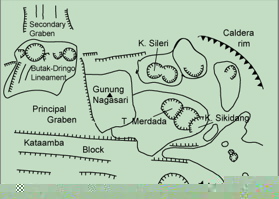


The reason Java has so much volcanic activity is twofold. The southern edge of the 600-mile long island is a section of the Ring of Fire that encircles the earth. This is where tectonic plates collide to create earthquakes and volcanoes. The deep trench in the following map indicates the subduction of one tectonic plate beneath another. The northern edge of the island is on the Alpide Belt, an unbreakable ridge that extends from Southeast Asia to the European Alps. The complex collisions of tectonic plates with the ancient ridge create enormous friction. This tectonic friction heats the Javanese land to molten levels. To relieve the growing pressure, the earth eventually erupts to form volcanoes or to release poisonous gasses.

The volcanic activity that led to the original evacuation of the area as a place of worship by the Dieng Plateau culture was not an isolated event. There have been at least 18 historic eruptions at Dieng since 1375. Eight of these explosive tectonic events resulted in fatalities. Noxious gasses emitting from ground fissures have proved just as devastating, if not more so. As recently as 1979, 149 people were killed as they fled the tectonic activity. When discovered it looked as if they were sleeping single file upon the road. As a further indication of its disruptive effect upon daily life, 1000 were also injured and 15,000 were evacuated from 6 villages. It is easy to see why the 9th century Javanese abandoned the mountaintops for the safety of the valley.
Lake Telega Warna & the Semar Cave
The Dieng Plateau had not yet revealed all of her wonders. We piled into the vans for another short drive to the southeast corner of the 36 square mile plateau. We eventually reach Lake Telega Warna. It is nicknamed the 3-color lake due to the multiple hues of the water. Lake Telega Warna is a volcanic crater lake. Although the water is not hot and bubbling, it is sulfuric, which is why the lake has such unusual colors.

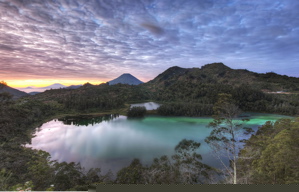
Lake Telegu Warna has great significance to the Javanese, as the Semar Cave is located there. Holy men have employed the cave as a meditation retreat for centuries.
Sumedi: "The devotee meditates in the cave for 3 days without food, coffee or tea - nothing but water. They emerge from the seclusion rejuvenated and inspired."
Me: "Not for the casual. Only serious practitioners dare enter in."
Sumedi: "True. Permission is required to use the cave."
Martin: "Suharto, Indonesia's leader for 30 years, regularly came to the Semar Cave to meditate. The seclusion might have provided him the focus and insight to survive the intrigues of his decades in power. He was given his nickname, the Puppet Master, due to his amazing ability to manipulate circumstances to his benefit. His meditation retreats also provided him with prestige and validation to the traditional Javanese, as he was aligning himself with a traditional power spot of Java. This is important because the leaders of Indonesia all come from Central Java. Even though Java is only the 4th largest island in Indonesia, it is the cultural and political center of the country.”

It is easy to see that the Dieng Plateau is not merely a relic of the past. Instead the special region continues to have major religious and cultural significance for the Javanese and by association Indonesia.
Shiva, a Dravidian God, predates the Aryan Gods
The temple shrines of the Dieng Plateau are mute testimony to the extensive influence of Indian culture upon Southeast Asia. The style of the shrines and the Mahabharata characters they were devoted to both came from India. Further Shiva, the main god of the temples, was also an Indian import.
Shiva, as mentioned, is one the 3 main gods of Hinduism. As the destroyer god, he is associated with death, destruction and rebirth. He is also considered to be the consummate yogi. However these austere associations provide no clue as to the meaning behind the obvious sexual symbolism of the temples, i.e. the milk-anointed lingam inside the yoni.
To understand the sexual connection to Shiva, let us examine the background. This exploration will also provide insight into Southeast Asia’s temple building frenzy.
According to many scholars, Shiva belongs to the Mohenjo Daro culture of the Dravidians. As evidence, there is a sculpture of an individual in a classic meditation posture from this period. The Mohenjo Daro civilization predates the Indo-European Aryan invasion that occurred during 2nd millennium BCE. The Aryans brought their Vedic religion with them.
After the invasion, the ritualistic Vedism of the Aryans coexisted with the original yogic-mystical tradition associated with Shiva. Presumably due to intermarriage, the two traditions eventually merged to become the mystical Hinduism of the Upanishads. This is when Shiva joined the elite pantheon of the gods.
Although absorbed into Hinduism, Shiva, as the ultimate yogi, was always more associated with practices than ideology. In the first centuries of the Common Era, these mystical practices became associated with Tantra.
Tantra's Pervasive Influence
Tantra could be viewed as a reaction to the elitism and world-denying nature of the primary religions of the time period. In contrast to both Hinduism and Buddhism, Tantra has no single unifying doctrine. Instead Tantra, like Shaivism, is associated with practices. Further these practices are oriented to the average citizen rather than the Brahmin priest, the ascetic yogis or the Buddhist monks. Accordingly, Tantra stresses the divine nature of this world, rather than denying its reality. In addition, the Goddess assumes great importance. In this context, Tantra is associated with both Shiva and his consort.
The Goddess has many names. Buddhists called her Tara, the Great Goddess of aboriginal India. Hindus called her Shakti, the cosmic force . The Javanese were particularly fond of Parvati, the India goddess of love and fertility.
In some ways, it could be said that Tantra represents the reassertion of the life-affirming orientation of the preceding earth-worshipping fertility cults of the Neolithic. These beliefs and practices had been suppressed or gone underground with the ascendance of the warrior cultures during the Metal Ages. Their military sky gods of war tended to exclude, rather than include, the goddess in their pantheon. As evidence, Tantra emerged in the areas that had not been thoroughly Brahminized by the Aryan conquerors, i.e. Bengal, northwest India and southern India.
Although originating around the 4th century in areas that still practiced pre-Aryan religions, Tantra had become a pan-Indian vogue by the 6th century and onwards. Its practices and orientation influenced all Indian religions, including Buddhism and Hinduism. Rather than purely mind-based meditation, the senses were engaged in the attempt to transcend the verbal duality. Mudras (hand positions), mantras (sacred sounds), yantras (visualizations of special mandalas) and sexual practices were all employed to achieve heightened spiritual states, i.e. union with god. Instead of rejecting the senses, Tantra used the sensual world to escape the fetters of the Mind.
Under the influence of Tantraid\langnp1033\langfenp1033 {\rtlch\fcs1 \af0 \ltrch\fcs0 \cs27\fs16\up6\insrsid9375929 \chftn }{\rtlch\fcs1 \af1 \ltrch\fcs0 \insrsid9375929 }{\rtlch\fcs1 \af1 \ltrch\fcs0 \insrsid9375929\charrsid12210632 My Person, of course. For I the Observer am theoretically unaffected by these events as I look on with care and interest. (Note these fancy sounding ideas merely suggest the constructs through which we attempt to organize an incredibly complex Reality \endash throwing words at the Incomprehensible Paradox at the Root of Being.}}}{\rtlch\fcs1 \af1 \ltrch\fcs0 \insrsid14747653\charrsid10645814 going to do? Will he be devastated by the required exertion? His spirit crushed and soul eradicated like the last time? Or will the running invigorate my nearly 60-year-old guy? Only the passage of the }{\rtlch\fcs1 \af1 \ltrch\fcs0 \insrsid8136309\charrsid10645814 Season}{\rtlch\fcs1 \af0 \ltrch\fcs0 \cs27\fs16\up6\insrsid8136309\charrsid10645814 \chftn {\footnote \ltrpar \pard\plain \ltrpar \s28\qj \fi360\li0\ri0\widctlpar\wrapdefault\aspalpha\aspnum\faauto\adjustright\rin0\lin0\itap0 \rtlch\fcs1 \af1\afs24 \ltrch\fcs0 \fs20\lang1033\langfe1033\cgrid\langnp1033\langfenp1033 {\rtlch\fcs1 \af0 \ltrch\fcs0 \cs27\fs16\up6\insrsid9375929 \chftn } {\rtlch\fcs1 \af1 \ltrch\fcs0 \insrsid9375929 }{\rtlch\fcs1 \af1 \ltrch\fcs0 \insrsid9375929\charrsid10645814 Memorial Day to Labor Day for Santa Barbara restaurants}}}{\rtlch\fcs1 \af1 \ltrch\fcs0 \insrsid8136309\charrsid10645814 }{\rtlch\fcs1 \af1 \ltrch\fcs0 \insrsid14747653\charrsid10645814 will reveal the present repercussions of our relation with ma Musa.}{\rtlch\fcs1 \af0 \ltrch\fcs0 \cs27\fs16\up6\insrsid14747653\charrsid10645814 \chftn {\footnote \ltrpar \pard\plain \ltrpar \s28\qj \fi360\li0\ri0\widctlpar\wrapdefault\aspalpha\aspnum\faauto\adjustright\rin0\lin0\itap0 \rtlch\fcs1 \af1\afs24 \ltrch\fcs0 \fs20\lang1033\langfe1033\cgrid\langnp1033\langfenp1033 {\rtlch\fcs1 \af0 \ltrch\fcs0 \cs27\fs16\up6\insrsid9375929 \chftn } {\rtlch\fcs1 \af1 \ltrch\fcs0 \insrsid9375929 In one of those par